Stephen Dal Nogare: The Person Behind the Award
LCGC North America
The Stephen Dal Nogare award is one of the oldest and most prestigious awards given in chromatography. Little has been written about Stephen Dal Nogare "the man" or his contributions to scientific knowledge, including his unique contributions to separations science. This article describes his scientific career and how it has influenced the practice of chromatography.
The Stephen Dal Nogare award is one of the oldest and most prestigious awards given in chromatography. Since 1972, it has been presented by the Chromatography Forum of the Delaware Valley, usually at the annual Pittsburgh Conference. Little has been written about Stephen Dal Nogare "the man" or his contributions to scientific knowledge, including his unique contributions to separations science. This paper describes his scientific career and how it has influenced the practice of chromatography.
The Chromatography Forum of the Delaware Valley is one of the oldest chromatography discussion groups in the world. It was founded in 1965 in Philadelphia, Pennsylvania. The purpose of the organization is "to foster a spirit of goodwill among those engaged in chromatographic work, to promote their educational and professional development, and to assume a place in the general scheme of professional societies by participating with them in the exchange of information of discussion of mutual interest."
The Stephen Dal Nogare Award in Chromatography was established in 1972 by the Chromatography Forum of the Delaware Valley to honor Dr. Stephen Dal Nogare, who was one of the founders of the Chromatography Forum and its second president. Dal Nogare died in 1968, after serving for six months as president. This annual award was established in his honor to be presented to an outstanding scientist in the field of chromatography. The awardee is chosen on the basis of his or her contributions to the fundamental understandings of the chromatographic process. It is one of the premier awards in separation science. The award symposium is held in conjunction with a national analytical meeting, the Pittsburgh Conference, with lectures given by the awardee and invited speakers selected by the awardee. To date, 35 scientists have received the Stephen Dal Nogare Award. Their names and affiliations at the time they received the award are listed in the table titled "Previous Recipients."

Previous Recipients*
Biography
Stephen Dal Nogare was born on July 23, 1922, in Marostica Vicenza, Italy (a medieval walled city near Venice). He came to the United States as a child. Stephen received the B.S. degree (Phi Beta Kappa; student address: "The Fifth Estate") in chemistry from Beloit College, Beloit, Wisconsin, in 1944, then entered the University of Wisconsin at Madison where he worked with Dr. Henry A. Schuette (1885–1978) for both the M.S. and Ph.D. degrees. Stephen received the M.S. degree in 1946 (thesis: "Studies on Elm and Sabadila Seed Oils") and the Ph.D. degree in 1947 (dissertation: "A Study of Chromatography Applied to the Higher Fatty Acid Methyl Esters"). After graduation, he joined the Plastics Department at DuPont, Wilmington, Delaware. He temporarily left DuPont in 1949 to accept a position as postdoctoral fellow with Prof. N. Howell Furman at Princeton University, Princeton, New Jersey. (Furman won the 1948 ACS Analytical Chemistry award). He returned to DuPont as a research chemist in the Polychemicals Department in 1950. In 1956, he became a supervisor and, in 1958, was promoted to research associate. From 1961 to 1967, he held the position of senior research associate.
In 1962, Dal Nogare coauthored with Richard S. Juvet., Jr one of the first books about gas chromatography (GC), Gas Liquid Chromatography: Theory and Practice. In 1965, he received the ACS Award in Chromatography and Electrophoresis and also the Lab Line Award in Chromatography at the Detroit ACS national meeting. Steve also initiated the first ACS Short Course in GC in 1966.
In 1968, Dal Nogare decided to enter academic life and accepted a position as Professor of Chemistry at the Virginia Polytechnic Institute, Blacksburg, Virginia. It was during his first year as a professor of chemistry that he died. Although his career in chemistry was short, he was recognized nationally.
One could best summarize Dal Nogare's contributions to the field of chromatography in the following sequence: he first studied GC instrument design and two of his co-workers helped construct his first gas chromatograph at DuPont. One co-worker, Dr. Frank Martinez, later founded the F&M Corporation (which later became Hewlett-Packard and later still, Agilent) in 1959. Steve was responsible for the interpretation of the theory of GC showing the importance of phase ratio β on resolution Rs and efficiency N. He investigated the optimization of column parameters and was a pioneer in the area of linear temperature programming and fast GC. He authored the Bi-Annual Reviews on Gas Chromatography for Analytical Chemistry from 1960 to 1966 and was a member of the advisory board of Analytical Chemistry until his death in 1968.
Scientific Contributions
One of the first publications while working at DuPont was the paper "Determination of Acetaldehyde and Acetone by the Iodoform Reaction" (1). The procedure was developed to fill the need for a method that could be used for the determination of very low concentrations of acetaldehyde or acetone in solution. It was based upon the reaction of these carbonyl compounds with hypoiodite to yield iodoform, which could be measured spectrophotometrically at 347 nm. Applications of this method were reported for acetone in cyclohexanol and 1,2-propylene glycol in ethylene glycol. This paper was followed by another nonchromatographic publication "Acidimetric Determination of Vicinal Hydroxyl by Means of Sodium Periodate" (2). Here, he and his coauthor described the advantage of low temperature (<0.10 °C) to provide a rapid and precise method involving only titration of the reaction mixture and a blank with standard alkali (NaOH) to a mixed indicator. Utilizing this method, they were able to analyze various glycols (ethylene glycol, 1,2,-propylene glycol, 2,3-butylene glycol, and glycerol) to a mean deviation of ±0.3 % relative. Both papers reflected the work he did in support of DuPont's chemicals businesses.
Steve's first paper utilizing chromatography while at DuPont was "Chromatographic Separation of Glycols and Monohydric Alcohols" (3). These separations were carried out on silicic acid and silicic acid–Celite columns. In both cases, the immobile phase was water; the alcohols being resolved with mixtures of carbon tetrachloride and chloroform; the glycols were resolved with mixtures of butanol and chloroform. His procedure was suitable for the separation of C1–C5 normal alcohols (isoalcohols were not distinguished from the normal alcohols). Only C2–C4 glycols, containing vicinal hydroxyl groups could be determined by this method. The chromatographic assembly apparatus is shown in Figure 1. The mobile phases were percolated through the column by means of air or nitrogen. By proper manipulation of the stopcocks, different solvents could be added successfully without interruption of column flow. Control of the flow rate was maintained by a manometer near the pressure inlet and a stopcock at the bottom of the column.

Figure 1
The alcohols were separated and determined by collecting 25-mL fractions, oxidized by excess dichromate, followed by the addition of solid potassium iodide, and then titrated with thiosulfate solution (Figure 2).
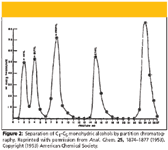
Figure 2
Alcohol mg = (mL thiosulfate for blank – mL thiosulfate for sample) × N of thiosulfate × eq. wt. alcohol
The glycols were separated and determined by collecting 10-mL fractions, reacting with sodium metaperiodate and the excess periodate titrated with sodium hydroxide according to the procedure of Dal Nogare and Oemler (2) (Figure 3).
Glycol mg = (mL NaOH for blank – mL NaOH for sample) × N of NaOH × mol. wt. glycol
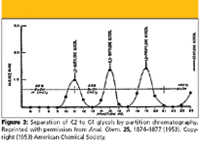
Figure 3
In 1956, Steve published a one-page article concerning the "Qualitative and Semiquantitative Tests for Amine Hydrochlorides on Paper Chromatography" (4). These two tests were based upon the reaction of chloride ion with silver ion to locate and estimate the amine hydrochloride spots by paper chromatography. Qualitatively, as little as 3γ of chloride ion could be detected (γ was the former symbol for microgram ). The positive test only required that the amines be in the hydrochloride form and not on the structure on the amine. Reproducibility of the semiquantitative test was found to be good for eight analyses of a pyrrolidine hydrochloride standard. The standard deviation of these analyses was 0.7%.
In 1956, Dal Nogare became interested in GC. He requested that his technical department build him such an instrument. Teaming up with Dr. Leo Safranski and a glass-blower by the name of Frank Martinez, they constructed a high temperature version of a gas chromatograph. It was Frank Martinez who saw the viability of a commercial product and received permission from DuPont to build and sell gas chromatographs out of his basement. In 1959, he formed the F&M Company (the F stood for Frank and the M stood for Martinez).
Dal Nogare and Safranski (5) developed a high-temperature gas chromatograph for the qualitative and quantitative separation of high-boiling organic mixtures. The partition columns were operated in the range of 150–350 °C. They were able to separate mixtures of hydrocarbons, esters, and glycols. The instrument used a platinum filament thermal-conductivity detector, which operated 10–100 °C higher than the column temperature. This detector temperature range was chosen to avoid condensation of the high-boiling components. They obtained excellent resolution on relatively short columns (2 ft × 4–9 mm i.d. borosilicate glass). These columns were chosen because of the small pressure drop and rapid throughput, thus, ensuring the reduction of thermal decomposition. The stationary phases used were 20–30% silicone grease (untreated high vacuum silicone grease, Dow-Corning, Midland, Michigan) or 20–30% commercial linear polyethylene. The inert solid supporting material was acid-washed Celite 545, 30/80 mesh fraction (Johns-Manville, Denver, Colorado). This coarse Celite offered low resistance to gas flow and, thus, fast elution. Semiquantitative analyses were estimated by the area summation method, where the percentage of a compound is obtained by the ratio of its area (peak height × width at half height) to the total area of the chromatogram (6). Employing this method to several high-boiling mixtures, the best agreement was obtained between area and weight percent rather than mole percent.
The response of the platinum-filament thermal conductivity detectors was measured over the range of 160–250 °C by comparing the peak heights and peak areas with a known equimolar hydrocarbon mixture (see Figure 4). The sample size injected was 3.0 μL (0.36 μL of hydrocarbon mixture in hexane solvent). Carrier gas (helium) flow was 35 mL/min; bridge current was 400 mA, and recorder sensitivity was 8 mV. As the temperature increased, the peak areas decreased and the peak heights increased. In the plot of peak height versus temperature, a crossover was seen for the curves of C14, C16, and C18 at about 215 °C. This pointed out the necessity of calibrating the detector response to known compounds under the conditions of the analysis, that is, the calculation of response factors first noted by Rosie and Grob (7).

Figure 4
Stephen then teamed up with Bennett, Safranski, and Lewis (8) and designed a GC apparatus suitable for analyses of impurities at the parts-per-million level (1–200 ppm), employing an amplifier to increase the signal from the thermistor detector. They also described techniques necessary for obtaining low noise and drift levels. Logical approaches to the problem were to find a more sensitive detector or to amplify the signal obtained from an available, stable detector. The combination of a thermal conductivity detector utilizing thermistors as sensing elements and an amplifier was selected as the best practical combination. This was based upon the high signal-to-noise ratio of thermistors and the availability of a suitable amplifier. The thermistors chosen were inexpensive, readily available, and usable at temperatures as high as 150 °C. It was found that this situation could be improved by increasing the column temperature during the separation process.
This article also discussed the amplification of the bridge signal and the conditions necessary for stable operation of a chromatographic apparatus. Several example analyses were presented to demonstrate this technique in organic analysis:
Interchangeable stainless steel columns were used that were 0.25-in. o.d. and 4–6 ft in length. Column packings were prepared from 80/100 mesh Celite 545 (Johns-Manville) coated with 25% of stationary phase.
- Isopropyl alcohol in benzene (Nujol liquid substrate).
- Benzene in toluene (tetraethylene glycol dimethyl ether liquid substrate).
- Cyclohexanol in toluene (Carbowax 1540 + 2.5% sorbitol liquid substrate).
- Methanol in water (25% Carbowax 400 liquid substrate). Note: A symmetrical methanol peak was obtained only after the Celite support was washed with hydrochloric acid, water, 1.0 M sodium hydroxide, and again with water.
After drying at 1000 °C, under vacuum, Carbowax 400, adjusted to an apparent pH of 7.8 with methanolic potassium hydroxide, was added. This treatment of Celite was recommended for polar materials that tended to form hydrogen bonds (J. Jack Kirkland, Grasseli Department, DuPont, Wilmington, Delaware, private communication).
- Impurities in cyclohexane (Nujol liquid substrate. The importance of this technique to trace analyses can better be appreciated when one realizes, at that time, no impurities were detected in the cyclohexane sample by infrared analysis).
- Impurities in reagent grade toluene (0.1–0.2% impurities) (tetraethylene glycol dimethyl ether liquid substrate 0.1–0.2% impurities).
A schematic diagram of the detector block, column, and vapor jacket is depicted in Figure 5.

Figure 5
An initial paper on programmed-temperature gas chromatography came in 1958 (9). Gas chromatograms, at that time, were usually obtained with the column maintained at a constant temperature. As a consequence, early peaks were sharp and closely spaced, while later peaks were low, broad, and widely separated. In addition, it was possible for higher boiling components to go undetected because of their extreme retention times. Dal Nogare and Bennett observed that with a linear column temperature rise and constant volume of mobile phase flow at the exit, each solute was eluted at a characteristic volume and temperature. Thus, by varying the column temperature over wide limits, mixtures with wide boiling point ranges could be separated rapidly. They observed that the most important feature of this variable temperature technique was that all solutes emerged as well defined peaks of nearly the same shape, even though their boiling points covered a 200 °C range.
Initially, temperature adjustments were obtained by using stainless-steel columns as the heating elements. By passing large currents from step-down transformers through the columns, temperature changes of as much as 400 °C could be attained in 2 min. By doing this rapid heating, they found that it was necessary to insulate the detector block from the column. At the time, it proved difficult to obtain insulating materials having the necessary strength to permit frequent column change and gas-tight coupling. Thus, they found that they could have equivalent performance with stainless steel columns directly wound with insulated heating wire (Glasohm). Using this arrangement, they could eliminate the bulky transformers associated with high-current, low-voltage work.
Figure 6A illustrates the result of increasing the column temperature linearly with time. The figure demonstrates the separation of a seven-component hydrocarbon mixture with a 4 ft × 5 mm i.d. column packed with 25% DC-200 silicone oil on 35/80 mesh Chromosorb. The temperature was programmed at 6 °C/min from 50 °C to 235 °C. The mobile phase (helium) was maintained at a constant flow rate of 35 mL/min at the exit of the column. Figure 6B is the same hydrocarbon mixture, at the same flow rate but under isothermal conditions of 168 °C. Figure 6A illustrates the impurities in n-hexane (peak 2); whereas in Figure 6B, peaks 1, 2, and 3 are incompletely resolved.

Figure 6
Similar results were obtained with a mixture of nine normal alcohols separated on the same column. The alcohols were temperature programmed from 48 °C to 245 °C at a constant mobile phase flow rate of 42 mL/min. The isothermal separation was carried out at 165 °C. During the isothermal run methanol and ethanol were not resolved and propanol was only partially resolved.
Peak areas were reproducible to ±3% over a sixfold change in heating rate. Varying the heating rate has a similar effect as varying flow rate during a constant temperature run. The mobile phase volume flow rate at the column exit was maintained constant by use of a Moore constant differential flow controller.
Dal Nogare and Safranski presented a paper titled "Separation Methods for Organic Mixtures" at the Symposium on an Analysis Group in an Industrial Research Organization before the Divisions of Chemical Education and Analytical Chemistry at the 130th Meeting of the American Chemical Society, Atlantic City, September, 1956 (10). In this publication, they discussed the techniques of separation by reaction, paper chromatography, partition chromatography, and GC.
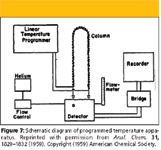
Figure 7
The publication that really laid the foundation for programmed-temperature GC as well as high-speed GC was a paper by Dal Nogare and Harden (11). In this paper, they detailed the chromatographic system for accomplishing good resolution as well as good control over the temperature programming system. Figure 7 shows a schematic diagram of their programmed temperature apparatus. The U-shaped, thin-walled, stainless steel column tubes were 4-ft long and had an internal diameter of 3/16 in. These columns were uniformly wrapped to within 1.5 in. of the ends with two parallel strands of insulated resistance heating wire having a total parallel resistance of 20 Ω. The columns could be supplied with 0–600 W of power. The columns were returned to room temperature by cooling with air supplied to a thin-walled metal cylinder surrounding the columns. The detector was made insensitive to column temperature changes by insertion of a large mass metal buffer block between the column and detector. This is shown in Figure 8. Figure 9 illustrates a schematic diagram of the closed-loop proportional temperature controller. Voltage to the Wheatstone Bridge was supplied from a 3-V dry cell in series with a fixed resistance.
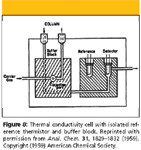
Figure 8
Helipot P-1 was coupled through a magnetic clutch and linearly driven by a synchronous timing motor. The clutch was actuated by the reset switch. As the temperature of the column is increased, the millivolt output of the thermopile, T-1 in series with the bridge output, increased and was applied as a negative feedback to the bridge. Column temperatures were measured by the thermocouple T-2 and indicated on a galvanometer. A light source and photocell were arranged on the set-point arm so that the metal vane of the galvanometer needle interrupted the light beam when the needle and set-point arm coincided. This action activated the reset relay, which disengaged the magnetic clutch, interrupting the programmer, and allowing the column to cool. A solenoid valve was simultaneously actuated to supply an air blast to the column to accelerate cooling.
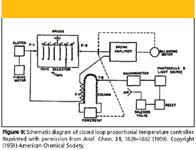
Figure 9
Figure 10 illustrates the performance of this apparatus for the separation of 1.0 μL of a C5–C10 mixture of n-paraffins. A 4 ft × 3/16 in. i.d. stainless steel column was used and was packed with 100/120 mesh C-22 firebrick coated with 15% DC-200 silicone oil (200 viscosity grade). The three chromatograms shown in Figure 10 were completed in 5, 10, and 28 min, respectively.
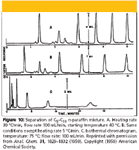
Figure 10
Dal Nogare and Langlois (12) published a theoretical paper in 1960 titled "Progammed Temperature Gas Chromatography" wherein they showed that solute behavior is predicted and confirmed experimentally by integrating an equation based upon heating rate, mass flow rate of the mobile phase, and starting temperature of the chromatogram. In this paper, they introduced proof of equal spacing of homologous series by programmed-temperature GC. Figure 11 shows that a uniform spacing of the peak maxima is obtained over a range of Rh values (heating rate in °C/min) from 5 °C to 30 °C . This would suggest that a correlation exists between retention time tR and carbon number, analogous to the correlation between log tR and carbon number obtained in isothermal chromatography.

Figure 11
Figure 12 illustrates the correlation for three values of Rh with a starting temperature of 40 °C, and a flow rate of 19 mg/min (M). They attributed the curvature seen at Rh values of 5 and 15 °C per min for tR values below 2 min from the T0 value being too high for the low-boiling homologues at the flow rate being used. They found that decreasing the flow rate improves the linearity and a similar improvement results from lowering the T0 value. For hydrocarbons a fairly good correlation was found between relative retention time and the flow-to-heating rate ratio, M/Rh. This is illustrated in Figure 13. A similar correlation of tR with Rh/M had been proposed by Habgood and Harris in 1960 (13).
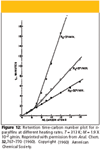
Figure 12
In 1961, Safranski and Dal Nogare published an article in Chemical & Engineering News (14) concerning the technique of gas–liquid chromatography. This was an easy to read description of the technique titled "Gas Chromatography, a Fine Touch in Separations." The authors described the principles of GC, which included retention behavior, the van Deemter plot, a basic diagram of a GC system, efficiency, resolution, dual approach to wide boiling range of sample components, and a discussion of scaling up from milligram to kilogram quantities. The article described, with a minimum number of mathematical equations, what was known of the theory of GC at the time. (This is a good reference, from the historical viewpoint, for those just entering the area of GC.)

Figure 13
Stephen Dal Nogare was indeed a rising star in the field of separation science who passed away early in his career. It is impossible to speculate on what he might have accomplished had he had a "full" career. During his short scientific career, he was in great demand as a speaker at local chemical meetings, international chromatography meetings, as well as an invited seminar speaker at universities. Dr. Dal Nogare was a serious bridge player, a Spanish guitarist, a modest person with a pleasing personality, and a very good friend.
References
(1) S. Dal Nogare, T.O. Norris, and J. Mitchell, Jr., Anal. Chem.23, 1473 (1951).
(2) S. Dal Nogare and A.N. Oemler, Anal. Chem. 24, 902(1952).
(3) S. Dal Nogare, Anal. Chem. 25, 1874 (1953).
(4) S. Dal Nogare Anal. Chem. 28, 903 (1956).
(5) S. Dal Nogare and L.W. Safranski, Anal. Chem. 30, 894 (1958).
(6) M. Dimbat, P. Porter, and F. H. Stross, Anal. Chem. 28, 290 (1956).
(7) D.M. Rosie and R.L. Grob, Anal. Chem. 29, 1263 (1957).
(8) C.E. Bennett, S. Dal Nogare, L.W. Safranski, and C.D. Lewis, Anal. Chem. 30, 898 (1958).
(9) S. Dal Nogare and C.E. Bennett, Anal. Chem. 30, 1157 (1958).
(10) S. Dal Nogare and L.W. Safranski, J. Chem. Ed. 35, 14 (1958).
(11) S. Dal Nogare and J.C. Harden, Anal. Chem. 31, 1829 (1959).
(12) S. Dal Nogare and W.E. Langlois, Anal. Chem. 32, 767 (1960).
(13) H.W. Habgood and W.E. Harris, Anal. Chem. 32, 450 (1960).
(14) L.W. Safranski and S. Dal Nogare, Chem. Eng. News, June 26, 102 (1961).

Detecting Hyper-Fast Chromatographic Peaks Using Ion Mobility Spectrometry
May 6th 2025Ion mobility spectrometers can detect trace compounds quickly, though they can face various issues with detecting certain peaks. University of Hannover scientists created a new system for resolving hyper-fast gas chromatography (GC) peaks.
Altering Capillary Gas Chromatography Systems Using Silicon Pneumatic Microvalves
May 5th 2025Many multi-column gas chromatography systems use two-position multi-port switching valves, which can suffer from delays in valve switching. Shimadzu researchers aimed to create a new sampling and switching module for these systems.
New Study Reviews Chromatography Methods for Flavonoid Analysis
April 21st 2025Flavonoids are widely used metabolites that carry out various functions in different industries, such as food and cosmetics. Detecting, separating, and quantifying them in fruit species can be a complicated process.

.png&w=3840&q=75)

.png&w=3840&q=75)



.png&w=3840&q=75)



.png&w=3840&q=75)











